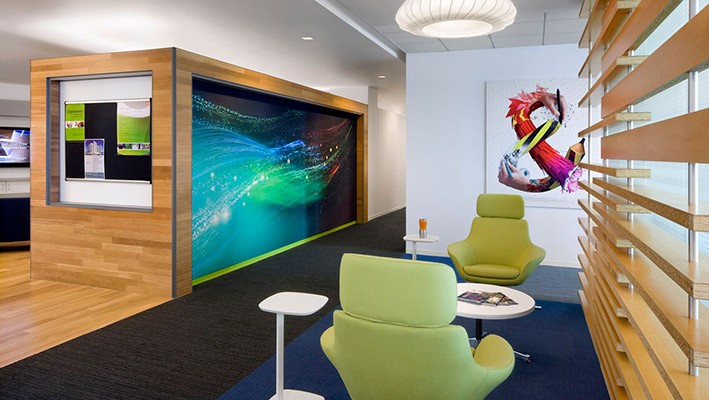Visitors to Adobe’s corporate headquarters in San Jose, California, tend to notice one of our more unusual features pretty quickly: They try to find a trash can, and can’t. Instead, they’ll find two receptacles – one for compostable items such food waste and paper, and another for recyclable items such as plastics. Adobe’s sustainability strategist , in partnership with our Global Workplace Solutions team, are intent on running our business responsibly by increasing operational efficiency, reducing our carbon footprint, and eliminating waste that goes into landfills, even if it initially takes some getting used to.
At the World Economic Forum in January, Adobe was included for the first time, as one of only two software companies, in the Global 100 Most Sustainable Corporations in the World Index. “It makes environmental sense and it makes economic sense,” Vince tells us. And as you can see from the following tour, it all begins at home…
Taking the LEED
The Leadership in Energy and Environmental Design (LEED) is a ratings system that ranks green homes, businesses, and neighbourhoods. More than 70% of Adobe’s global footprint is LEED certified, with our corporate headquarters in San Jose (and our San Francisco offices) earning a prestigious 100% LEED Platinum ranking. In our conversation with Vince, he points out that the company has never been afraid to invest in technologies that may be new, or those that are still in the experimental stage. Executives from other companies perhaps see only risk, but Adobe is seeing significant ROI, cutting our own costs by making intelligent and efficient use of America’s precious national resources.
Smart Floors. Buildings with Brains?
How smart can a structure be? Pretty clever, if you know where to make the necessary adjustments and investments. Strategic energy-saving initiatives at many of Adobe’s buildings around the globe have been designed to incorporate a sixth sense.
At Adobe’s San Jose headquarters, the buildings are divided into “neighborhoods.” Each neighborhood is occupant-driven, with the workspace coming alive when someone enters the area. The temperature, lighting, and other environmental controls are automatically adjusted accordingly. Why have the lights and heat on if no one is home? There is so much to be saved by simply switching off unnecessary environmental controls when there is nobody in the space to enjoy them. Energy consumption is cut, and there are economic savings to boot.
Better yet, open office plans have been designed to take advantage of natural light and constructed to provide a bright, warm, and positive work environment. There are thousands of women and men who have helped make Adobe the success that it is. And they are happier and healthier for the effort that has gone into building a workplace designed to make them feel great to be there.
More than 180 energy-efficiency projects have been implemented by Adobe since 2002. These include low-carbon Bloom Box energy fuel cells on our headquarters’ and San Francisco office rooftops, and, of course, our distinctive windspires. This has resulted in an impressive reduction in resource consumption across the board. Electricity purchasing from the grid has dropped by 50%, and domestic water use has plummeted by almost 80%. All of this adds up to significant savings, in terms of financial and natural resources.
Reduce, Reuse, and Recycle: An Everyday Workday Reality at Adobe
A culture of sustainability is an intrinsic aspect of everyday life at Adobe HQ. Employees are surrounded by inspiring workspaces constructed with materials made with the lowest environmental impact possible. In addition, there are projects in place aiming to monitor and continually improve the air quality, temperature, and humidity settings at each employee’s workstation.
“There is a real focus on our people,” says Vince. “Our company is based on people being creative. If it is comfortable here—and the workspaces are ‘cool’—people will want to come work here.”
An open and healthy working environment boosts employee satisfaction and productivity, and knowing that your office is helping to contribute to a more sustainable ecosystem probably doesn’t hurt morale. It seems that waste reduction, energy conservation, great interior design, and a major enterprise organization’s economic achievement need not be at odds with each other at all. Get the mix right, and you’ll be on your way to following a world-class, eco-friendly recipe for success.




